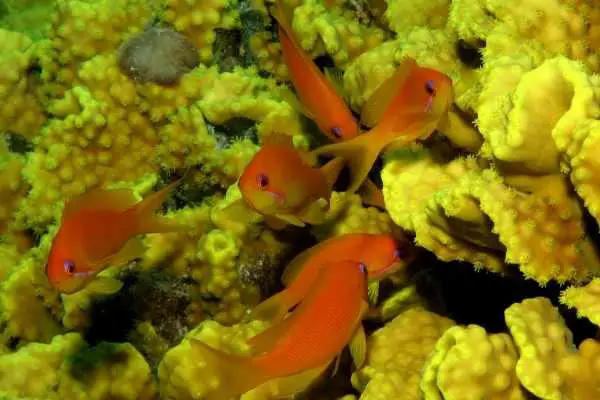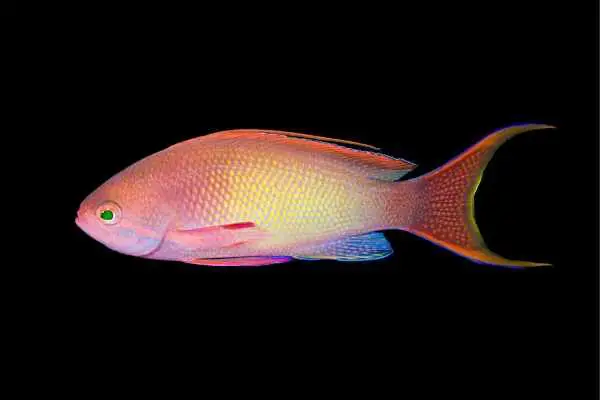Lyretail anthias (Pseudanthias squamipinnis) are some of the most attractive and active saltwater fish an aquarist can covet. They rarely cause problems with their management – earning bonus points. And their habits of swimming throughout the water column can even draw out shier species you might have in your aquarium.
Table of Contents: Lyretail Anthias Care
While lyretail anthias may not present too many challenges, you’ll still want to keep an eye on the various links below to make sure you’re not missing any of the quirks in their care. Or you can read through the entire article and savor all of the details of these colorful relatives of groupers (yes, groupers).
- Quick Facts
- Description of the Lyretail Anthias
- Lyretail Anthias Lifespan
- Creating the Ideal Lyretail World
- Lyretail Anthias Diet
- Lyretail Anthias Behavior and Tank Mates
- Breeding the Lyretail Anthias
- Pros and Cons
- For More Information
Quick Facts
- Common Names: Lyretail anthias, Scalefin, Blue-eye anthias, Purple-eye anthias, Sea goldie, Warpaint anthias, Orange fairy basslet, Lyretail fancy bass, Lyretail coralfish, Orange basslet, Orange butterfly perch, Orange sea perch, Red coral perch
- Scientific Names: Pseudanthias squamipinnis
- Size: 5 inches (12.7cm)
- Minimum Tank Size: 150 Gallons (568L)
- Reef Safe? Yes
- Care or Experience Level: Moderate
- Preferred Diet: Carnivore
- Original Part of the World: Indo-Pacific

Description of the Lyretail Anthias
Lyretail anthias come in some of the brightest colors you’ll find out on a reef. And that applies to the males AND females. Sexually dimorphic, you can quickly sort the two based on the color palette of their scales. Males use a red or pink hue, while females come in an orange or yellow shade. Both sport a bluish-purple ring around the eyes that streaks back along the sides to the pectoral fins. (And explains the common names of blue-eye anthias or purple-eye anthias – depending on how you decide to label that particular color)
But the males of the species take things a little further. Depending on what region you spy them, you’ll see different colors and patterns. It’s one way to differentiate them. (Females keep their colors the same, no matter where you spot them) The only thing that remains constant in male lyretails is the elongated dorsal spine. Of course, when you’re looking at a male patrolling around the edges of his harem, the color difference is usually easy enough to spot without looking for the spine.
Lyretail Anthias Lifespan
Lyretails aren’t the largest fish in the world, which is why they swim in schools around outer reef slopes throughout the Indo-Pacific region. (Safety in numbers) Those flashing colors stand out in a crowd, especially since they don’t go particularly deep into those drop-offs. And while they DO share a familial branch with groupers, they aren’t aggressive enough to hold their own against predators.
As such, it’s no real surprise their lifespan only comes in around 5-6 years. But since they’re not particularly difficult to manage in captivity, you can expect to see that for your lyretail anthias without too much trouble.
Creating the Ideal Lyretail World
You’ll find lyretail anthias throughout the Indo-Pacific region. They cluster throughout the Red Sea and the east coast of Africa, with another significant population around Fiji, Indonesia, and Melanesia. Divers frequently spot them at depths between 30-100 feet (10-30m). The schools remain active above the reef without straying too far from branching corals. That way, if an aggressive predator comes into the area, they have a ready hiding place available.
Even if you plan to keep your marine tank stocked with peaceful species, you still want to adopt a similar theme. That means a nice combination of open swimming room with places for shelter. Odds are your lyretails will need a break from the lights, even if they’re not dashing for safety. Most corals demand high-intensity lighting, but that’s too strong for lyretail anthias. They prefer subdued lighting. You don’t need to swap out your bulbs, though, provided you offer caves and overhangs that give them shade.
Live rock will split the difference between providing sustenance and lending a hand toward shelter. You don’t want to crowd the tank, though. Lyretails constantly remain active throughout the day. But if you aquascape the back and sides of your aquarium, you’ll keep your colorful fish happy.

Lyretail Anthias Tank Size
If you only plan to keep a single lyretail anthias, you can get away with a 70-gallon (265L) tank. But for groups? You’ll need to increase that size. A small harem of five needs 150 gallons (568L). And if you go for a stunning shoal of eight? Bump up to 180 gallons (681L). Remember, you’re balancing swimming space with aquascaping. So while these fish aren’t huge, their needs ARE.
You also need to invest in a quality protein skimmer. This will help you stay on top of your water quality between water changes. Lyretails need pristine water conditions to remain happy and healthy. And while filters go a long way to helping, a protein skimmer is best, particularly as you’ll want a refugium to help with their feeding needs. You’ll also want a wave maker to assist with the water flow. Lyretail anthias remain active at all times. And in the wild? They hang out around coral drop-offs where there’s a strong current. You need to duplicate that.
Are Lyretail Anthias Reef-Safe?
As active planktivores, lyretail anthias are reef-safe fish. They may investigate your live rock, but they won’t hassle your corals. Even your other invertebrates are safe from harm.
Well, unless you have tiny ornamental shrimp in your tank. Those poor crustaceans may end up on the menu. But as long as you’re maintaining an adequate diet (with the correct number of feedings), even your shrimp should stay safe from the school’s grazing.
Lyretail Anthias Diet
Lyretail anthias pose some trouble to aquarists when they first enter an aquarium. They need a little time to get acclimated. This means you’ll want to focus on quality proteins (frozen or live work best) to tempt their appetites. Once they’ve settled in, though, you shouldn’t have a problem.
Lyretails are planktivores, and they’re not picky about their menu choices. Setting up a refugium will make your life easier. Otherwise, you’ll want to feed them at least 3-4 times a day to meet their high metabolic needs. (After all, they remain active at all times – that burns a TON of calories) If you only offer a couple of feedings, they’ll drop weight and start to get stressed.
You CAN train them to accept commercial flake and pellet foods. But you’ll find them chasing down proteins faster:
- Amphipods
- Brine shrimp
- Copepods
- Mysis shrimp
- Rotifers

Lyretail Anthias Behavior and Tank Mates
In the wild, lyretail anthias form schools over coral outcrops. A single male will patrol a territory, monitoring the harem of his chosen females. And while they’re peaceful fish, males WILL challenge one another over females and space. You’ll also see lyretails challenge other anthias species, especially if they look similar.
As such, you’ll want to choose your school make-up carefully. NEVER keep more than one male in the same tank. You can keep a shoal of females without a problem. And if you add a male to their mix? You won’t see any issues. It’s only when you decide to sneak another male into the aquarium that you’ll end up with problems. And try to avoid adding any other anthias species to be on the safe side.
The school won’t have problems with other peaceful fish. You’ll see them swimming throughout the day, actively feeding. They don’t startle easily. This makes them an ideal fish if you have shier species that need reassurance. And while you can get away with almost any like-minded fish as a tank mate, some of the best include:
- Assessors
- Blennies
- Dwarf angelfish
- Gobies
- Squirrelfish
- Tilefish
Breeding the Lyretail Anthias
Lyretail anthias are protogynous hermaphrodites. This means all fish are born female. The dominant fish in the group then becomes male. The sex change can take place as rapidly as a few weeks. This leads to a complex social battle within the group in the wild (and it can happen in your reef tank if you’re not careful).
Lyretails spawn pelagically. In the early evening hours, pairs release their gametes into the ocean current. The male performs a courtship display, attracting the female’s attention. He then chases her toward the surface, and they release their sperm and eggs. The eggs remain with the current for anywhere from 20 hours to three days. As soon as the fry hatch, they’re capable of feeding on their own.
If you have a large enough tank, you CAN breed lyretails. All you need to do is dim your lighting in the evenings regularly to simulate normal nightfall. You’ll see the spawning behavior. You can then collect the eggs and transfer them to a breeding tank for safety. Make sure you pay attention, though – it’s a QUICK dash to the surface. Plenty of aquarists have missed the signs, leaving the eggs to get snacked on by the residents of their reef tank.

Pros and Cons
Lyretail anthias aren’t the most challenging saltwater species to manage. Even so, they have their quirks. And you need to balance their pros and cons before you decide to bring a harem into your reef tank.
Pros
- Lyretail anthias are one of the hardiest in their group. You still need to quarantine them, but they don’t usually present as many problems as other anthias.
- Lyretails are active swimmers, often encouraging shier species to venture out in a tank.
- With the proper tank size and an egg collector, you can easily induce spawning in your lyretail harem.
Cons
- Lyretail anthias don’t always ship properly, leading to a period of acclimation when they first enter a tank.
- Because of the social dynamic of lyretails, you need to consider keeping a single fish (particularly if you have a male) – or make sure you have plenty of room available.
- You’ll need a refugium attached to your marine aquarium or set reminders for feedings four times a day to meet the metabolic needs of these active fish.
For More Information
Whether you decide to keep a lone lyretail anthias (would you go for a male or female?) or spring for an entire shoal, you probably want to learn a little more about them. Who wouldn’t? They’re engaging fish with pleasant personalities!
This YouTube video shows a shoal of lyretails on a reef in the wild:
Want to know about some of the best lyretail anthias tank mates?
- Diamond goby
- Engineer goby
- Firefish goby
- Lawnmower blenny
- Mandarin goby
- Midas blenny
- Neon goby
- Starry blenny
- Tailspot blenny
And while they look nothing alike, behave nothing alike, and don’t seem to share ANY characteristics, maybe you’re interested in that grouper connection anthias have:
Conclusions
Lyretail anthias rank as the easiest in their group to manage. And while they have a few quirks, if you do some homework first, they’re not too challenging to keep and enjoy. With the potential to coax your nervous fish out of hiding, how can you resist?
References
- “Pseudanthias squamipinnis.” 2008. Tropical Fish Magazine.
- Fenner, B. “Fancy Sea Basses, The Anthiadinae.” WetWebMedia.
- Michael, S. 1990. Reef Fishes, Volume 1.
- Randal, J.E., Allen, G.R., and Steene, R.C. 1990. Fishes of the Great Barrier Reef and Coral Sea.

Leave a Reply